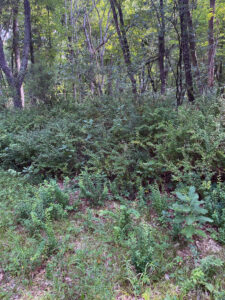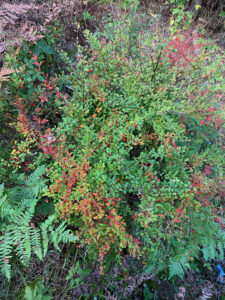By Erika Segerson-Mueller, DNR Invasive Plant Program Specialist, Oshkosh Service Center;
erika.segersonmueller@wisconsin.gov or 715-492-0391

Japanese barberry can quickly grow into dense infestations in forests, outcompeting native plants and providing ideal hiding places for white-footed mice that serve as hosts for blacklegged ticks. / Photo Credit: Wisconsin DNR
Most small talk in Wisconsin revolves around three things: the weather, the Green Bay Packers … and in the summer months, how darn bad the ticks are.
If you spend time working or playing outside, you likely know firsthand that ticks in Wisconsin are serious business. Because most of us prefer to minimize our interactions with the tiny arachnids, here’s another tick prevention tactic to add to your arsenal — along with clothing treated with permethrin, long socks and frequent tick checks: Rid your property of Japanese barberry.
Japanese barberry (Berberis thunbergii) is an invasive plant in Wisconsin. Originally introduced as an ornamental plant, Japanese barberry was thought to be a suitable replacement for common barberry (Berberis vulgaris).
Common barberry was once abundant across the eastern United States but has been largely eradicated because it is an alternate host to Black Stem Rust (Puccinia graminis), a fungus of wheat crops that causes significant damage.
Both plants are regulated by the Wisconsin Invasive Species Rule NR40. Common barberry is listed as Prohibited, while Japanese barberry is listed as Restricted.
So, what does this invasive plant have to do with ticks?
Dense infestations of Japanese barberry provide an ideal habitat for blacklegged (deer) ticks. Tightly growing shrubs produce low light levels and high humidity, allowing Lyme disease-causing bacteria to flourish on small mammals like white-footed mice. Infected mice are bitten by ticks, which can then carry the disease to other animals and humans.
Multiyear studies show an increase in blacklegged ticks in areas with large populations of Japanese barberry. As the number of Lyme disease-spreading ticks increases, so do potential levels of Lyme disease in humans.
In addition to increased deer tick presence, Japanese barberry infestations have prominent barbs that are uncomfortable to navigate through. Once established, the shrubs shade out native plants and change foraging habits of wildlife. White-tailed deer avoid browsing barberry because of its many spines; they instead feed on native plants, which gives barberry an additional competitive advantage.
To identify Japanese barberry, look for alternating spatula-shaped leaves that cluster above many spines or barbs. The shrubs have arching stems that overlap to form its dense thickets.
In mid-summer and often persisting into winter, bright-red, oblong berries are found on the stalks individually or in clusters of two to four. Winter can be a good time to identify barberry on your property as the bright red berries and distinctly barbed branches can be easy to spot sticking out among dead plants or snow.
As with most invasive plants, multiple control efforts will be required to rid your property of Japanese barberry. Small to medium-sized barberry can be pulled or dug year-round. Wear thick gloves to protect your hands from the many spines on the shrub. Larger bushes may require the use of a digging tool to fully remove the root crown. Learn more about control methods by visiting the University of Wisconsin-Extension Japanese barberry factsheet.
If you like the ornamental function of Japanese barberry and are looking for a similar shrub that is adaptable and deer-resistant to use as hedging, there are several suitable native alternatives. Choose one of the options below instead of Japanese barberry to reduce your risk of contracting Lyme disease.
Try black chokeberry (Aronia melanocarpa), winterberry holly (Ilex verticillata), or bayberry (Myrica pensylvanica) plants instead. For a plant with a similar purple foliage in the summer, ninebark (Physocarpus opulifolius) is a good choice.

Look for spatula-shaped alternating leaves, bright-red berries and sharp spines to determine if shrubs are invasive Japanese barberry. / Photo Credit: Wisconsin DNR
Learn more about these options and other suitable native replacement for invasive plants in the Landscape Alternatives brochure produced by the Midwest Invasive Plant Network (MIPN) and the Woody Invasives of the Great Lakes Collaborative (WIGL).
